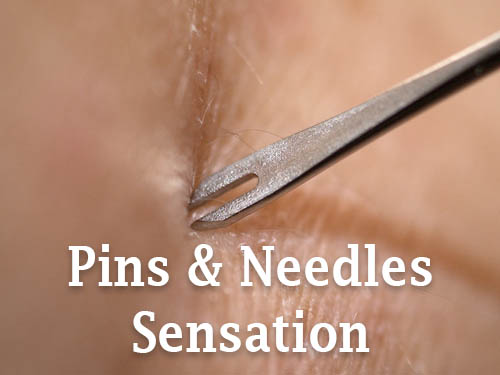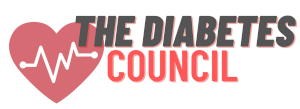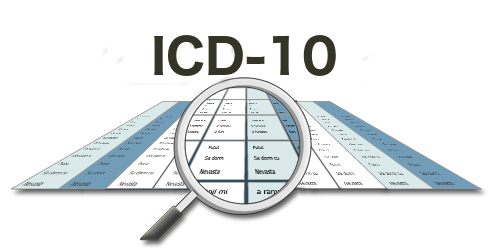
The sensation of “pins and needles” is technically known as a form of paresthesia. Paresthesias are abnormal sensations and include sensations of burning, tingling, prickling, skin crawling or itching, often in the hands and/or feet. All the forms of paresthesia are due to nerve damage, either because of some disease affecting the nerves (eg. Multiple sclerosis or diabetes), by traumatic injury or entrapment (eg. Carpel tunnel syndrome), by strokes or by tumors pressing on the nerves.[1]
Paresthesias can also be caused by Vitamin B12 deficiency, heavy metal poisoning, alcohol abuse and by a low-functioning thyroid (hypothyroidism).[2] Paresthesias can also be caused by various medications such as antihistamines, blood pressure medication, antibiotics and other medications can cause paresthesias such as that sensation of pins and needles.
Just about everyone has experienced temporary paresthesias—these are those times when your leg “fell asleep” as you sat cross-legged or your hands were tingling or vibrating for some time after weed whacking or using some power tool. Paresthesias are usually not painful unless they are cause by spinal or traumatic injury, but they can become chronic (long-term) and can affect your overall quality of life.
For example, if the “pins and needles” sensation doesn’t let you sleep, that can affect your quality of life. If that “pins and needles” sensation make it difficult for you to type, hold a pen, use a tool, sew, garden or perform another activity that you enjoy—or that you have to do—THAT can affect your quality of life.
In diabetes, paresthesias often precede and are part of a complication of diabetes, peripheral neuropathy. Peripheral neuropathy is believed to result from chronically high levels of blood sugar. The high levels of blood sugar can act as a toxin on the nerve cells, damaging them over time.
I recommend you read the following articles:
What Can You Do about “Pins and Needles” in Diabetes
There is quite a bit you can do to relieve the discomfort (and possibly pain) that the sensation of pins and needles brings.
First, because there can be other causes of paresthesias, you can have yourself tested for the most common, such as hypothyroidism with a simple blood test. You can also make sure you are tested for Vitamin B12 deficiency.
You can take Vitamin B12 as a supplement, but it is probably more efficient to take a B-complex vitamin because ensuring that you have enough B vitamins can also help with energy levels and your overall health. Talk to your doctor about whether any medications you may be on could be causing the sensation.
Second, you can make certain that your blood sugar values are always within your goals. As mentioned, it is believed that nerve damage in diabetes is due, at least in part, to the toxic effect that high concentrations of sugar have on nerve cells. Keeping your blood sugar levels well within your goal is one approach that, needless to say, carries other advantages as well. Paresthesias can improve over time—usually over a few months.
Third, keep moving! Exercise increases insulin sensitivity or the ability of your cells respond to insulin and how well your cells can remove the sugar from the blood. Keeping your physical activity levels up will also improve circulation to your hands and feet, the parts of the body most commonly affected by the pins and needles of diabetic neuropathy.
Fourth, you may benefit from adding antioxidants either in your diet, by increasing your intake of berries, grapes, nuts (walnuts, almonds, Brazil nuts, peanuts, pecans and cashews), dark green vegetables, sweet potatoes, carrots, winter squash and green tea. These are all foods that you will find in diets like the Anti-inflammatory diet or the Mediterranean diet, often recommended for people with diabetes.
Fifth, you can increase the circulation in your hands and feet by giving yourself (or getting FOR yourself) a foot and hand massage. Avoid getting any lotion between your toes to reduce the risk of over-moisturizing (and fungal infections). You can also use circulating foot baths to increase the circulation in your feet.
Sixth, you can use a topical cream—Capsaicin—on your hands and feet. Capsaicin, found in most drug stores, contains a substance derived from cayenne peppers—it depletes something known as Substance P which is a chemical messenger for pain signals. If the Substance P is depleted by the capsaicin, the pain signals don’t get through anymore.
Make sure that after you apply the Capsaicin cream, you wash your hands thoroughly—remember, it is derived from the cayenne pepper plant and you DON’T want to get that near your eyes! There are two concentrations of capsaicin available—0.25% and 0.75%-- try the less concentrated one first, though you may need a prescription for a higher level of capsaicin, which is applied as a patch.[3]
Finally, you may want to consider acupuncture to treat the sensation of pins and needles that you are experiencing.[4] There are a number of studies indicating that acupuncture can improve the functions of the nerves and help relieve the symptoms of pins and needles.[5]
For more symptoms and treatments related to diabetes read these:
Questions and Answers
Q: Does having pins and needles mean you have diabetes?
- The sensation of pins and needles can indicate a number of problems, including diabetes.
Q: I am at high risk for diabetes. Could I have pins and needles in my fingers and toes without being a diabetic?
- Possibly, but chronic pins and needles sensations do indicate that nerves are involved and you should have yourself check out.
Q: I have recently been getting a lot of pins and needles. Is it a problem?
- It may be if there is no known reason that you are experience the pins and needles sensation (ie. sitting cross legged or falling asleep on your arm). Make an appointment with your physician—chronic (long-term or recurring) pins and needles sensations need to be evaluated by a doctor.
This was an article about symptoms that might be related to diabetes. Now you know what to keep an eye out for.
TheDiabetesCouncil Article | Reviewed by Dr. Christine Traxler MD on June 10, 2020
References
- http://www.ninds.nih.gov/disorders/paresthesia/paresthesia.htm
- http://www.rightdiagnosis.com/p/paresthesia/causes.htm
- http://www.ncbi.nlm.nih.gov/pmc/articles/PMC3169333/
- https://www.acufinder.com/Acupuncture+Information/Detail/Treating+Peripheral+Neuropathy+with+Acupuncture+and+Chinese+Medicine
- http://www.ncbi.nlm.nih.gov/pubmed/17355547





